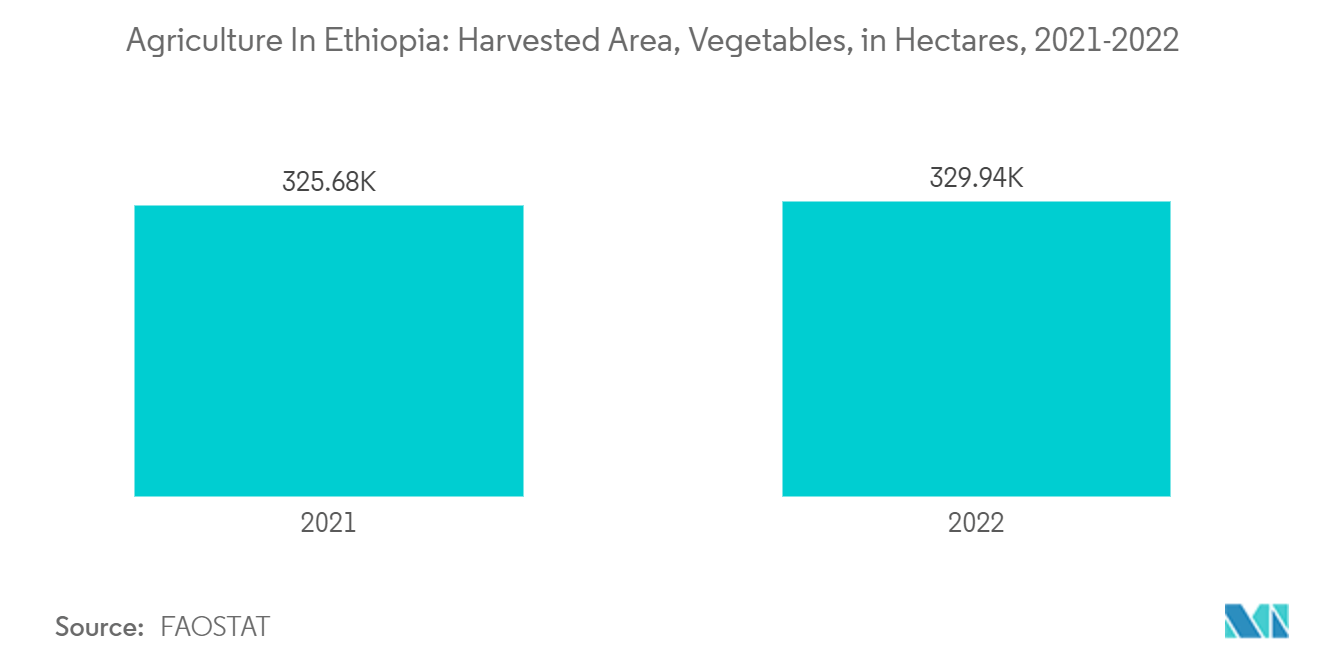Market Trends of Ethiopia Agriculture Industry
Increasing Focus on Agriculture Development
- The key component of Ethiopia's agriculture policy is expanding the primary and processed agricultural products. As a result, the Government of Ethiopia has identified two of its crucial areas, which are increasing the productivity of smallholder farms and expanding the large-scale commercial farms. To spur the economic growth of Ethiopia in the future, the government has initiated the Second Growth and Transformation Plan (GTP II) to make the agro-processing industry a single entity by encouraging private sector investments within the country through commercial and contract farming. The GTP II is also aimed at developing agro-processing and value addition of agricultural products in the country.
- The Ethiopian government has established the Agricultural Transformation Agency (ATA) to address the problems of the agricultural sector in Ethiopia. It aims to transform smallholder farmers into commercialized players with high incomes. In 2021, the Government of Ethiopia (GOE) embarked on a 10-year economic development plan (2021-2030) where agriculture is the top priority sector and enhancing agricultural production and productivity is one of the major strategic pillars. The 10-year development plan also aims at boosting agricultural export revenues and substituting imports by reducing production costs by using unutilized arable land, modernizing production systems, and improving technology uptake.
- Due to the increasing agriculture business in the country, the area of various crops grown in the country has gradually increased over the years. For instance, according to Food and Agricultural Organization Statistics (FAOSTAT), the harvested area of vegetables increased from 325,677 hectares in 2021 to 329,940 hectares in 2022. Therefore, the government's favorable policies to increase private partnerships in the agricultural sector are anticipated to drive the country's agricultural sector.

The Food Crops Segment Holds Significant Share by Type
- Production of food crops such as cereals accounts for one of Ethiopia's significant shares of the economy from the agricultural sector. Over 80.0% of agricultural land is used to produce cereals, using 60.0% of the rural workforce. According to FAOSTAT, the area under cereals cultivation increased from 10,582,984 hectares in 2021 to 11,236,673 hectares in 2022. Cereals are an essential part of the Ethiopian diet. As per the International Trade Administration report, over 50% of the daily caloric intake of an average household in Ethiopia is from wheat, sorghum, and corn.
- Despite the high domestic grain production, the country is still dependent on wheat imports, which are managed entirely by the state-trading arm of Ethiopian Trading Business Corporation. Despite the country's reliance on wheat imports, the Government of Ethiopia vowed to begin exporting wheat to neighboring countries by tapping into its huge production potential and expanding the wheat production area. Furthermore, despite the huge availability of fertile land for agriculture, the country fails to produce high yields of cereals due to low infrastructure, backward technology implementations, limited input availability, and lack of machinery and irrigation facilities.
- The government has also established agricultural machinery rental service centers in grain-producing regions to capacitate and increase the efficiency of farmers. The country's efforts to increase the production areas aimed at attaining self-sufficiency and export of grains in the international market are anticipated to be the major factors driving the growth of agriculture in Ethiopia.


